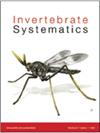Resolving the taxonomy of the Antarctic feather star species complex Promachocrinus ‘kerguelensis’ (Echinodermata: Crinoidea)
IF 1.9
2区 生物学
Q3 EVOLUTIONARY BIOLOGY
引用次数: 0
Abstract
ABSTRACT An increasing number of Antarctic invertebrate taxa have been revealed as cryptic species complexes following DNA-based assessments. This ultimately necessitates a morphological reassessment to find traits that will help identify these cryptic or pseudocryptic species without the need for sequencing every individual. This work concerns comatulid crinoid echinoderms long considered to represent a single, circum-Antarctic species, Promachocrinus kerguelensis. The first molecular studies sought to distinguish the diversity in the complex and understand the constituent species distributions but stopped short of formal taxonomic assessment. Here, we continued to increase sample representation around the Southern Ocean and sequenced the mitochondrial COI gene for all new specimens, and additional genes for a few representatives. We also elucidated previously unappreciated features, particularly body pigmentation and morphology of the centrodorsal ossicle in an attempt to diagnose some species morphologically and based on DNA data. The species complex within Promachocrinus is here resolved into P. kerguelensis Carpenter, 1879, P. vanhoeffenianus Minckert, 1905, P. joubini Vaney, 1910, P. mawsoni (Clark, 1937) comb. nov. (transferred from Florometra) and four previously unnamed species, P. fragarius sp. nov., P. unruhi sp. nov., P. uskglassi sp. nov. and P. wattsorum sp. nov. Although most species can be distinguished morphologically, several cannot be reliably separated without DNA data. All sequenced species are essentially circum-Antarctic, with the notable exception of P. wattsorum sp. nov. that is restricted to the Prince Edward Islands in the sub-Antarctic Indian Ocean and P. vanhoeffenianus that is only known from the type locality in the Davis Sea. The vast nature of the Antarctic and Southern Ocean ecosystem dictates large scale sampling to understand the full extent of the biodiversity. ZooBank: urn:lsid:zoobank.org:pub:F871CDC8-973B-48CE-8A61-33658D4EB4B1解析南极羽星物种复合体Promachocrinus‘kerguelensis’的分类学(棘皮动物门:Crinoidea)
摘要:在基于DNA的评估之后,越来越多的南极无脊椎动物分类群被揭示为隐蔽物种复合体。这最终需要对形态学进行重新评估,以找到有助于识别这些隐蔽或伪隐蔽物种的特征,而无需对每个个体进行测序。这项工作涉及长期以来被认为代表一个单一的环南极物种——克氏原棘皮动物。最初的分子研究试图区分复合体的多样性并了解组成物种的分布,但没有进行正式的分类学评估。在这里,我们继续增加南大洋周围的样本代表性,并对所有新样本的线粒体COI基因进行测序,对少数代表的额外基因进行测序。我们还阐明了以前未被重视的特征,特别是身体色素沉着和中央背侧小骨的形态,试图根据DNA数据从形态学上诊断一些物种。Promachocrinus内的物种复合体在这里被分解为P.kerguelensis Carpenter,1879,P.vanhoefenianus Minckert,1905,P.joubini Vaney,1910,P.mawsoni(Clark,1937)comb。nov.(从Florometra转移而来)和四个以前未命名的物种,P.fragarius sp.nov.、P.unruhi sp.nov..、P.uskglassi sp.novs.和P.wattsorum sp.nov。尽管大多数物种可以在形态学上区分,但如果没有DNA数据,就无法可靠地分离出几个物种。所有已测序的物种基本上都是环绕南极的,除了P.wattsorum sp.nov.和P.vanhoeffenianus,前者仅限于亚南极印度洋的爱德华王子群岛,后者仅在戴维斯海的模式区已知。南极和南大洋生态系统的广阔性质要求进行大规模采样,以了解生物多样性的全部范围。ZooBank:urn:lsid:ZooBank.org:pub:F871CDC8-973B-48CE-8A61-33658D4EB4B1
本文章由计算机程序翻译,如有差异,请以英文原文为准。
求助全文
约1分钟内获得全文
求助全文
来源期刊

Invertebrate Systematics
生物-动物学
CiteScore
4.30
自引率
9.10%
发文量
35
审稿时长
>12 weeks
期刊介绍:
Invertebrate Systematics (formerly known as Invertebrate Taxonomy) is an international journal publishing original and significant contributions on the systematics, phylogeny and biogeography of all invertebrate taxa. Articles in the journal provide comprehensive treatments of clearly defined taxonomic groups, often emphasising their biodiversity patterns and/or biological aspects. The journal also includes contributions on the systematics of selected species that are of particular conservation, economic, medical or veterinary importance.
Invertebrate Systematics is a vital resource globally for scientists, students, conservation biologists, environmental consultants and government policy advisors who are interested in terrestrial, freshwater and marine systems.
Invertebrate Systematics is published with the endorsement of the Commonwealth Scientific and Industrial Research Organisation (CSIRO) and the Australian Academy of Science.
 求助内容:
求助内容: 应助结果提醒方式:
应助结果提醒方式:


